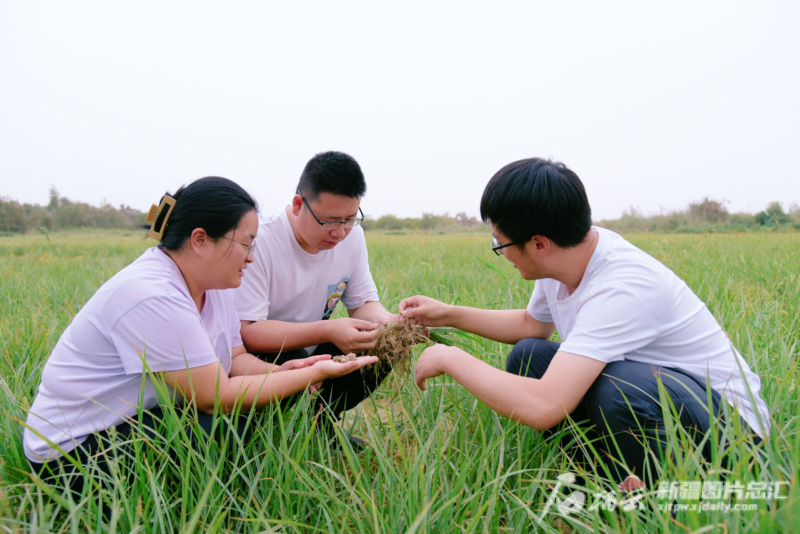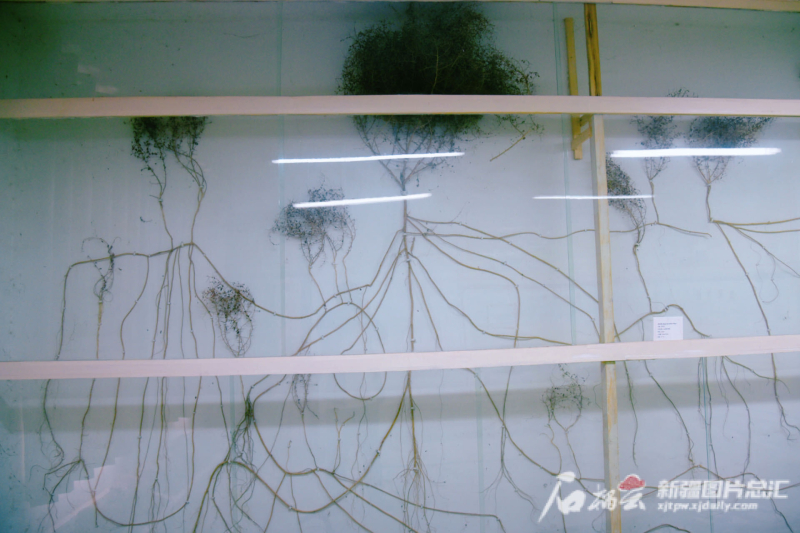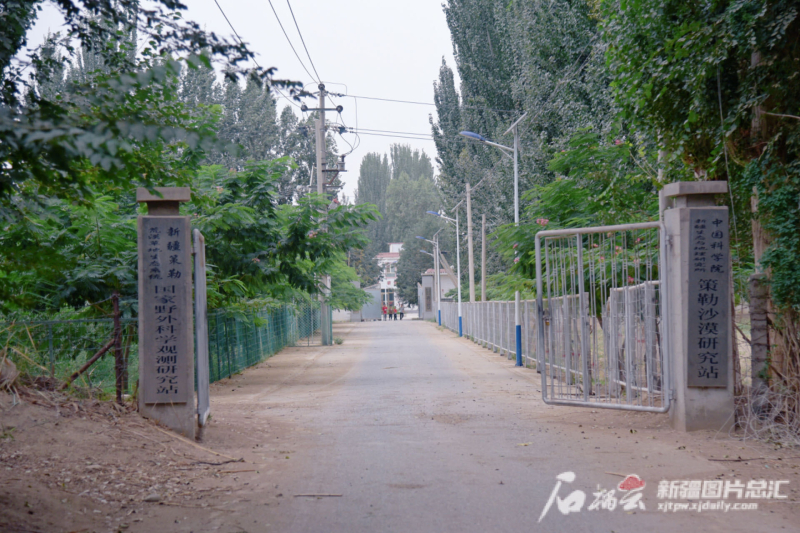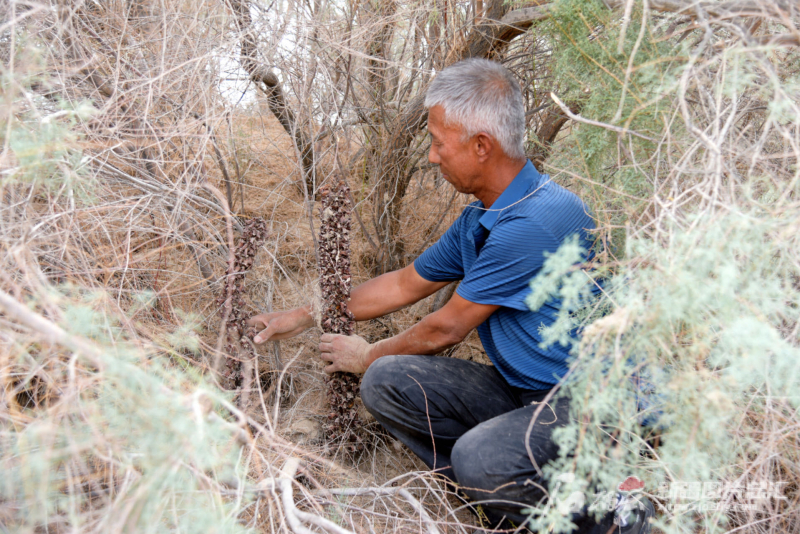Shiliuyun-Xinjiang Daily (Reporter Parizat Abdu, Correspondent Zhang Yahui) news: On August 24, 2023, the experimental demonstration area of the cultivation technology of cyperus esculentus in the Chinese Academy of Sciences' Xinjiang Institute of Ecology and Geography Cele Desert Research Station (hereinafter referred to as "Cele Desert Research Station") is full of greenery. The above-ground part of the cyperus esculentus can be used as excellent forage, and the underground tubers can be used to extract oil, which can also prevent wind and fix sand, as well as provide high economic benefits." Du Yi said, holding a handful of cyperus esculentus.

Photo taken on August 24, 2023 shows Du Yi (first from left) and her colleagues check the growth of cyperus esculentus at the experimental demonstration area of the cultivation technology of cyperus esculentus in the Chinese Academy of Sciences’ Xinjiang Institute of Ecology and Geography Cele Desert Research Station, northwest China’s Xinjiang Uygur Autonomous Region. (Photo by Zhang Yahui)
Du Yi is a student of the Chinese Academy of Sciences’ Xinjiang Institute of Ecology and Geography, and she has been working on cyperus esculentus research at the Cele Desert Research Station for three years. She told reporters that at present, Cele Desert Research Station is comparing different irrigation conditions and different planting density conditions for cyperus esculentus to overwinter and grow, hoping to form a high-yield and high-efficiency technology model of retaining seeds for overwintering in a typical sandy and windy area.
Cyperus esculentus is not the only plant that has both ecological restoration and economic value at the Cele Desert Research Station.
In the specimen room of the Cele Desert Research Station, there is a camel thorn, which has a root system of two to three meters long, and the part exposed to the ground is 50 to 60 centimeters high, with many branches.

Photo taken on August 24, 2023 shows the specimens of the camel thorn in the specimen room of the Chinese Academy of Sciences’ Xinjiang Institute of Ecology and Geography Cele Desert Research Station, northwest China’s Xinjiang Uygur Autonomous Region. (Photo by Zhang Yahui)
Camel thorn is a desert deep-rooted plant that grows in arid and semi-arid areas, and has a great ability to prevent wind and fix sand, as well as being an excellent forage grass. "Camel thorn grows in the desert area of southern Xinjiang, the root system of it is well developed, and the roots of it can reach up to ten meters long, which is suitable for the saline and alkaline land. It can provide theoretical references for ecological restoration and artificial planting by studying the technical difficulties related to the planting of camel thorns." Zeng Fanjiang, director of the Cele Desert Research Station, told the reporters.
In the early 1980s, drift sand approached the edge of Cele County, with the desert front only 1.5 kilometers away from the County. In order to deal with the severe situation of land desertification in the 1,400-kilometer wind-sand fringe along the southern edge of the Tarim Basin, the government of Xinjiang Uygur Autonomous Region decided to set up the Cele Desert Research Station. Over the past 40 years since the establishment of the station, three generations of scientists have fought against the sand and engaged in scientific research, creating a comprehensive protection system for the management of drift sand in the arid zone. This has resulted in the retreat of sand front by more than 10 kilometers, lifting the threat of the sand to the county, and also effectively protecting the agricultural production of 38 natural villages along the front of the wind and sand.
Cele Township is where the Cele Desert Research Station is located, and is also the biggest beneficiary of sand control and prevention.
"The village was surrounded by desert in the past, the villagers were afraid to go out on the sandy days, the drift sand blocked the door and they could not even go out, and the farmland would also be affected by the sands and winds." Zhang Yuanhui, Party branch secretary of Tuopa’airike Village in Cele Township, said that nowadays, the desert has been pushed back by 20 kilometers, and villagers are no longer afraid of the sand. The village has planted different varieties of peaches such as nectarine, flat peach, etc. During the peach ripening season, the thousand mu of peach orchard is green as far as the eye can see.

Photo shows the exterior view of the Chinese Academy of Sciences’ Xinjiang Institute of Ecology and Geography Cele Desert Research Station in northwest China’s Xinjiang Uygur Autonomous Region. (Photo by Zhang Yahui)
How to make people's lives more prosperous by letting the greenery generate revenue?
Combined with the local development reality, Zeng Fanjiang led the team to focus on the development characteristics of different townships, put forward six kinds of technical systems to promote the local farmers and herdsmen to increase their income, including the fruit processing type, underforest farming type, compound management type, facility agriculture type, recycling economy type, and eco-industry type. It has effectively solved the key technical problems for increasing the income of farmers and herdsmen in six local villages, and has enabled the farmers and herdsmen in the six villages to increase their income by more than 10 million yuan in total. In addition, the station successfully broke through the technology bottleneck of planting cistanche deserticola on the red willow, established a variety of planting modes for forest fruits and grasses, and provided technical support and demonstration cases for the development of the local ecological industry.
Walking into the planting base of the cistanche deserticola in Tuopa’airike Village in Cele Township, Turgun Matsadi was watering and weeding at cistanche deserticola field. "The cistanche deserticola is about to harvest after more than a month. Cistanche deserticola can not only prevent wind and fix sand, but also allow us to earn money." Turgun planted 3,000 mu of red willow cistanche deserticola, of which 1,000 mu can be harvested this year, and is expected to earn more than 300,000 yuan this year.

Photo taken on August 24, 2023 shows Turgun Matsadi checks the growth of cistanche deserticola at the planting base of the cistanche deserticola in Tuopa’airike Village in Cele Township, northwest China’s Xinjiang Uygur Autonomous Region. (Photo by Zhang Yahui)
At present, the planting area of cistanche deserticola in Tuopa’airike Village reaches 16,000 mu, and the villagers' per capita net income in 2022 reaches 16,000 yuan, with the income from cistanche deserticola planting accounting for 40% of the total income.
With the help of the research results of Cele Desert Research Station and the scientific and technological support, since 2004, when Cele County promoted the artificial planting of red willow and cistanche deserticola, it has built a comprehensive management demonstration base integrating experiment, demonstration and popularization of science, and carried out the demonstration and popularization of red willow and cistanche deserticola planting, collection and management techniques. As the largest cistanche deserticola planting base in Cele County, the area of red willow and cistanche deserticola planted in Cele Township has expanded from the initial 8,000 mu to 40,000 mu, with an annual output value of 12 million yuan, and the average output of the cistanche deserticola can reach 120 kilograms per mu or more.
"At present, under the joint efforts of all sides, Cele County has achieved a tremendous transition from desert expansion to afforestation expansion. But we still have a long way to go in making the sand industry develop better and realizing scientific sand control and sustainable development of economic benefits." Zeng Fanjiang said that Cele Desert Research Station will accelerate the transfer and transformation of scientific and technological achievements to help rural revitalization.
(A written permission shall be obtained for reprinting, excerpting, copying and mirroring of the contents published on this website. Unauthorized aforementioned act shall be deemed an infringement, of which the actor shall be held accountable under the law.)









